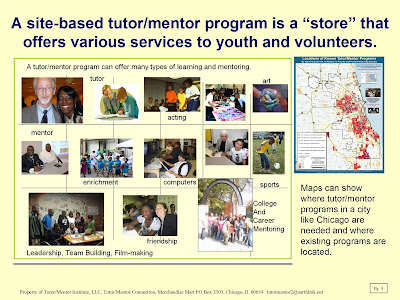When I say tutor/mentor program I'm describing a place where a core group of adults make a long-term commitment to help kids move through school and into adult lives. This concept map is one way to visualize the types of learning activities that are needed at each grade level.
Here's another visualization that communicates the same idea. From 1973 to 1990 I work at the Montgomery Ward corporate headquarters in Chicago, in the retail advertising department. We were one of many functional teams in Chicago who worked to help over 400 stores reach customers in 40 different states.
I've used my experiences at Wards in forming the ideas of the Tutor/Mentor Connection. By building and maintaining a map-based directory of Chicago non-school tutor and/or mentor program locations, anyone can take on a role that helps programs in different places become world-class at what they do.
Let's think about that a bit more. Take a look at this graphic. Every non-school organization is a small business involved in distributing a wide range of learning and mentoring opportunities to youth who live near where the program operates. Such programs are needed in every high poverty neighborhood.
The boxes at the left side of this graphic represent functional areas which need to be filled in each of these small non profits, but few have the money to hire people with each of these skills. Thus, a few people try to do work they are not really good at, and some things don't get done at all.
What if?
What if leaders in different business sectors recruited people from their companies/industries to offer their talent to fill these roles? What if their goal was that every non profit were reached by business volunteers and/or teams who filled these functional roles?
For instance, the legal industry could be recruiting lawyers to be tutors/mentors, to be board members, and to provide pro-bono legal representation. Maps on the Chicago Bar Association, and law firm web sites could show the distribution of these teams, with a goal that 100% of programs be ultimately reached.
The same strategy could be happening in accounting, consulting, advertising, marketing, technology, and other industries, meaning each program and every poverty neighborhood, would have the manpower, talent and capacity to do more to help kids move through school and into careers.
Let's look at another graphic. In this case the boxes on the left illustrate different forms of learning that should be available to youth in schools and non-school programs in every high poverty neighborhood.
Manufacturing companies, Banks, Communications companies and Media could be developing volunteer-based programs that they distribute to sites throughout the city. There are many examples where companies already provide programs that teach industry values. However, I'm not aware of any industry using maps to show the distribution of their programs to youth programs throughout the Chicago region (or any other city).
I mentioned that I worked for Montgomery Ward. Like all retail stores, Wards was an intermediary, enabling manufacturing companies, like Procter & Gamble, to put their soap and other products on store shelves where customers could find it and buy it.
These companies did more than offer a good product at a fair price. They also offered point-of-purchase signing, employee training, and advertising dollars. In other words, they did everything they could to make sure a store had success in selling their product to potential customers.
Here's another graphic that illustrates this idea.
Chicago has great museums who work hard to attract visitors to their facilities. Each museum has a variety of student engagement programs. However, I'm not sure if any have a product-distribution strategy, where they are trying to reach non-school programs through the Chicago region, with a package of program activities and support systems that would result in more non-school youth-serving organizations including museum-led programs that build student interest in the information each museum specializes in.
I call this strategy Total Quality Mentoring (TQM).
I created this graphic in the 1990s to communicate the idea of a youth organization site being a "store" where all sorts of tutoring and/or mentoring experiences are made available to students by volunteers who bring these experiences with them from the places where they work or the colleges they attended.
I created this TQM presentation to illustrate this idea. Every volunteer who enters a tutor/mentor program this fall has the potential to be a "TQM Evangelist" who tells people in his workplace, family and college network about the program where he/she volunteers with the goal that teams of people will form along the spokes of this wheel, and innovate ways they can bring their work experiences, talent and other resources to tutor/mentor programs in every part of the city.
Read more articles on this blog and the Tutor/Mentor Institute, LLC web site and reach out to me so I can help you learn how to use this information.
 As we move through the 2016-17 school year planning teams can form that by next spring are beginning to reach out to bring their support to more of the different tutor/mentor programs in Chicago (see my list).
As we move through the 2016-17 school year planning teams can form that by next spring are beginning to reach out to bring their support to more of the different tutor/mentor programs in Chicago (see my list).
By the middle of 2018 we should be seeing maps at business and college locations and web sites that show a distribution of their support to different poverty neighborhoods of Chicago and different cities.
Maybe one of our Presidential, Congressional or Local Elected Leaders will become a champion of this strategy? It's possible if you share this with them.













No comments:
Post a Comment